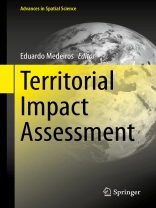This book presents a comprehensive debate and analysis of existing Territorial Impact Assessment (TIA) methodologies, designed under the auspices of the ESPON programme since the mid-2000s. This is intended to serve as a TIA handbook for the reader, to better understand the main differences, advantages and shortcomings of each presented TIA methodology. It also serves as a manual for professors and students in the field of policy evaluation, and territorial analysis, as it presents concrete examples of the implementation of each TIA methodology, their formulas and intrinsic evaluation elements.
The purpose of policy evaluation methodologies is to check the main effects of private and public investments, in order to report back to policymakers and citizens on their efficiency and effectiveness. Over the past decades, both in Europe and worldwide, there has been an increasingly awareness of the need to implement/reinforce policy evaluation practices, at all territorial levels. At the same time, it has become widely accepted that many policy interventions produce impacts in more than one dimensions of territorial development. In this context, the use of a holistic and territorial approach for policy impact assessment evaluation has rapidly been adopted by the European Commission as a mainstream policy evaluation procedure.
قائمة المحتويات
Chapter 1 Introduction – Editor.- PART I Territorial Impact Assessment (TIA): mainstream methodologies.- Chapter 2 TARGET_TIA .- Chapter 3 TEQUILA model.- Chapter 4 STe MA.- Chapter 5 ESPON EATIA: A qualitative approach to Territorial Impact Assessment.- PART II Territorial Impact Assessment for cross-border cooperation programmes.- Chapter 6 Assessing the impact of legislation and implementation in border regions. Experiences with a bottom-up approach from the German, Dutch and Belgian border regions.- Chapter 8 Implementing TIAs for Cross-Border Cooperation.- PART III – Territorial Impact Assessment: alternative models and complementary approaches.- Chapter 9 From Territorial Impact Assessment to Territorial Foresight.- Chapter 10 The LUISA Territorial Modelling Platform and Urban Data Platform. An EU experience.- Chapter 11 Applying counterfactual impact evaluation approaches to test territorial effects of Policies’.- Chapter 12 Territorial Impact Assessment applied to Regional Smart Specialisation Strategies. Contributions to a more integrated and multidimensional approach.
عن المؤلف
Eduardo Medeiros is a Geography Professor, and an Integrated Researcher of DINÂMIA’CET-IUL, Instituto Universitário de Lisboa, and a DG REGIO expert.












